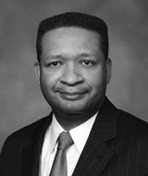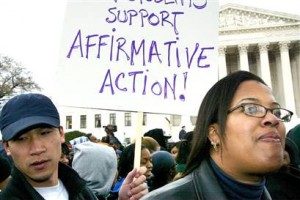 The Supreme Court announced last week that it will revisit the perennial hot button of affirmative action in the college admissions process. The case, which involves the University of Texas’ admission practices, is a constitutional cliff-hanger: the 5-4 majority in 2003 for the proposition that colleges can treat race as a vague, non-specific factor rested on the now retired reed of Sandra Day O’Connor. Her successor, Samuel Alito, has a history of skepticism toward racial preferences. Adding to the peril for defenders of affirmative action, the court’s emerging liberal superstar, Elena Kagan, has recused herself.
The Supreme Court announced last week that it will revisit the perennial hot button of affirmative action in the college admissions process. The case, which involves the University of Texas’ admission practices, is a constitutional cliff-hanger: the 5-4 majority in 2003 for the proposition that colleges can treat race as a vague, non-specific factor rested on the now retired reed of Sandra Day O’Connor. Her successor, Samuel Alito, has a history of skepticism toward racial preferences. Adding to the peril for defenders of affirmative action, the court’s emerging liberal superstar, Elena Kagan, has recused herself.
 The Texas plan provides automatic admission for the top ten percent of students in every Texas high school. To fill out its freshman class, the university deploys a formula that does not assign a specific point value to race, but unmistakably makes it a factor. It is precisely the kind of half-measure the court endorsed nine years ago, and which seems to be the prevailing practice in all manner of elite public and private colleges 9 (full disclosure: it’s also the kind of plan that admitted me to Harvard 25 years ago).
The Texas plan provides automatic admission for the top ten percent of students in every Texas high school. To fill out its freshman class, the university deploys a formula that does not assign a specific point value to race, but unmistakably makes it a factor. It is precisely the kind of half-measure the court endorsed nine years ago, and which seems to be the prevailing practice in all manner of elite public and private colleges 9 (full disclosure: it’s also the kind of plan that admitted me to Harvard 25 years ago).
Count me as a conflicted spectator who chafes at both poles of the debate.
Conservatives are way too quick to idealize college admissions as meritocratic instruments: the reality is that they have never worked that way and that’s not a bad thing. Public universities are taxpayer subsidized institutions that exist to maximize upward mobility, and few of them would serve that value (or fill their classrooms) by graduating classes that consisted exclusively of high school academic superstars.
The idea that racial classifications are unnecessary to achieve racial diversity is also a notion that doesn’t hold up well. Every major study on the subject suggests that other instruments of “diversity”, like working class status, or first generation college status, tilt toward the admission of more non-affluent whites and don’t do much to advance ethnic minorities. Even if a wholesale shift toward class as a “plus factor” delved into looser criteria like debt to asset ratio, or home ownership, the best evidence is that nothing assures racial diversity better than race preferences.
But the liberal side of the scale has its own outsized flaws. The principle that public institutions ought to “look like” their population or taxpayer base can be turned on its head: shouldn’t every member of that same constituent base feel he has an equal shot at clearing the admissions gatekeepers? If accountability is at stake, surely one measure of accountability is whether a public university favors one section of the community or treats all comers equally.
The other liberal case for affirmative action is invariably that a “diverse” campus environment is one that is more dynamic and that exposes young adults to an array of attitudes and views they would otherwise never encounter. It’s a theme that resonated thirty or forty year ago, much less so today. There are precious few white students in 2012 that experience a sudden cultural frisson from a talented black or brown student occupying the seat next to them. The notion that it takes a suspiciously consistent percentage of minorities (say, 10 percent v. 5 percent) to jar white students into a tolerant sensibility, or to ease blacks “out of their shell”, seems outmoded, if not outright ridiculous, for a millennial generation that takes race far less seriously than their parents still do.
The middle to upper income 18 to 22 year old adults who frequent college campuses, and live in the throes of a thoroughly integrated television and music culture, won’t become more intolerant if their campus experiences somehow become less racially diverse. It should also be noted that a retreat from race conscious admissions would almost certainly not deprive a single African American or Hispanic student of a college education; at most, it would redistribute the same kids to schools perhaps one competitive notch below their target, i.e., the University of Maryland rather than the University of Michigan. (It’s worth pointing out that one likely outcome of a turn from racial preferences at elite public colleges would be more diversity at second-tier institutions as well as private liberal arts schools).
In addition, the case for diversity in a multi-cultural democracy can turn into what conservatives like to deride as a “spoils system” based on political chits. Do the most stalwart advocates of affirmative action really spend much time worrying if the descendants of East Asian Indians and Arab Muslims are well represented at Ann Arbor or Austin? If not, does it show the hand of a political agenda that defers to the most potent minority voting blocs while giving lip service to the ideal of inclusiveness?
The best case for ending racial preferences isn’t a pollyannish claim that they don’t matter and that freshman classes will look about the same with or without them. To the contrary, the strongest argument is that they do matter, but less today than yesterday, and that the cost–closing doors to kids who don’t get an unearned edge–has outpaced the gain. It’s a notion, by the way, that doesn’t concede that public education should completely get out of the business of taking race into account. The Court’s decision in 2007 limiting race as an element in K-12 district assignments was much too oblivious to the documented linkage between integration and high achievement in secondary schools, and the reality that re-segregated schools are typically sub-standard and that parents have limited options to test other markets.
But the reflexive instinct that ending race conscious college admissions is a disaster in the making? It’s no longer a serious claim. Even a full-scale retreat would hardly disenfranchise African American students or consign them to sub-par schools that lack adequate resources. The market of higher education is much too robust for that. Lacking a more compelling rationale, the case for college affirmative action segues into one more claim that political ground gained shouldn’t be abandoned, even if the ground is just the power of one interest group throwing its weight against another.
(Cross-posted, with permission of the author, from OfficialArturDavis.com)









Leave a Reply